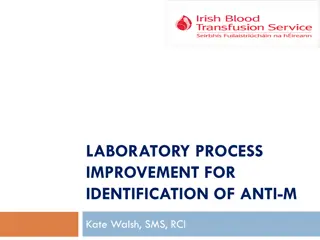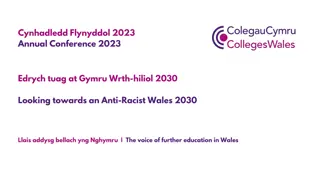Understanding Anti-Racist Education: A Comprehensive Overview
This content provides insights into Anti-Racist Education (ARE), discussing its essence, what it is not, and its pedagogical considerations. It delves into the importance of fighting systematic racism, embracing student identities, and creating inclusive classroom environments to engage meaningfully. Pedagogical approaches empowering student collaboration and control over learning goals align with ARE principles, contrasting with traditional transmission models that suppress student experiences.
- Anti-Racist Education
- Systematic Racism
- Inclusive Classrooms
- Empowering Pedagogy
- Student Collaboration
Download Presentation

Please find below an Image/Link to download the presentation.
The content on the website is provided AS IS for your information and personal use only. It may not be sold, licensed, or shared on other websites without obtaining consent from the author. Download presentation by click this link. If you encounter any issues during the download, it is possible that the publisher has removed the file from their server.
E N D
Presentation Transcript
So, Youre Planning an ARE (Anti-Racist Education) Course Laura Kaplan, PhD & Kyomi Gregory-Martin, PhD, CCC-SLP ARE Co-Coordinators Brandyn Heppard, PhD Faculty Fellow Faculty Center
Our Goal for Todays Session To discuss what ARE is Understand what ARE is not Provide a comprehensive training for Pace University Faculty
What is NOT Anti-Racist Education? Multicultural education Global education Promoting heroes and holidays Celebrating individual differences Circumventing discussion of issues of power and privilege A path to higher status (i.e., Eurocentric) knowledge
What Anti-Racist Education Is? It recognizes the need to fight against systematic racism, colonization, and cultural oppression. is grounded in the lives of our students. draws on the voices and perspectives of those being studied. teaches through dialogue. critically supports students identities. embraces and recognizes the value of students home languages. critiques the official knowledge that has historically been Eurocentric invites students to engage in real social and political issues. creates classroom environments where students can meaningfully engage with each other.
Pedagogical Considerations Encouragement of student to student talk in a collaborative learning context. A focus on developing higher level cognitive skills rather than factual recall. Task presentation that generates intrinsic rather than extrinsic motivation. Its opposite is the transmission model or banking model of education (Freire). A genuine ARE orientation is impossible within a transmission model of pedagogy.
Pedagogical Considerations In short, pedagogical approaches that empower students and encourage them to assume greater control over setting their own learning goals and to collaborate actively with each other in achieving these goals are consistent with ARE. Transmission models exclude, and therefore, effectively suppress, students experiences. Consequently, these teacher-centered approaches do not allow for validation of minority students experiences in the classroom.
Assessment Historically, assessment has served to legitimize the educational disabling of minoritized students by locating the academic problem within the student themselves. This process has obfuscated the subtractive nature of the curriculum, the exclusionary orientation of teachers towards minoritized communities, and transmission models of teaching that suppress students experience and inhibit them from active participation in learning.
Assessment The alternative role required to reverse the pathologizing function of assessment can be termed an advocacy orientation. When a variety of cognitive and academic tasks and instruction is individualized and interactional, teachers have considerable opportunities to observe students.
Does Anti-Racist Education Encompass Other Categories such as LGBTQ+ Students or Religious Diversity? We pay conscious and explicit attention to race and ethnicity in our ARE- designated courses. We place an emphasis around race and ethnicity so that we can facilitate the painful and powerful conversations around systemic racism, the legacies of colonization, and the realities of cultural oppression. In our courses, we recognize the various aspects of intersectionality that relate to culture, gender identity, religion as well as race and ethnicity. We welcome a discussion of other isms in all of our courses.
Who teaches ARE courses? An ARE course can be taught by anyone in the University and be attached to classes at any level (100 level through grad). Like the Writing-Enhanced Courses, the attribute is attached to the course and a specific the faculty member.
How do I make my courses ARE? Faculty can submit their courses for the attribute using the Google form. The form asks for a sample syllabus and short explanation of what aspects of the course align with the ARE LOs. The submission then goes to the ARE taskforce with reps from every school for review. Courses are then recommended to the curriculum committee for approval or sent back to the Faculty member with notes, thoughts, or suggestions. Faculty can choose to revise OR submit their course directly to the Curriculum committee.
What makes a course ARE? 1) Inequalities 2) Knowledge-Making 3) Intersectionality 4) Change-Making 5) BIPOC Contributions & Perspectives
Inequalities Develop a critical awareness of how racial and ethnic inequalities, antagonisms, and/or solidarities emerge through individual, collective, and institutional actions; and/or how they change historically; and/or how they vary geographically or transnationally.
Class Examples: Inequalities Critically assess how actions, structures, and systems lead to racial/ethnic inequalities. American Studies, Dyson: Gain a familiarity with theories and critiques of capitalism and colonization by studying struggles for social change and racial justice in the United States, its borderlands, and other transnational contexts. Finance & Society course, Lubin: Explore the role of the financial system in promoting social welfare as well as in perpetuating historical inequalities; examine the embedding of financial markets in social arrangements; and interrogate economic policies that unfairly disadvantage members of some marginalized classes.
Knowledge-Making Explore how race/ethnicity shape the production of knowledge in a field, discipline, or practice; and/or compare and debate theories, analytical perspectives, and research methodologies on race/ethnicity and racism across disciplines.
Class Examples: Knowledge-Making Explore how race/ethnicity shape a field. Political Science, Dyson: Examine and trace how race and racism shape international relations as an academic field, set of encounters, and foreign and immigration policymaking practices; utilize postcolonial, decolonial, Black Internationalism, and other subfields of international relations to address and challenge the role of racism in global interactions and knowledge production. English, Dyson: Interrogate how Standard Edited American English in its structures and fields of reception serves to marginalize the role of vernacular languages and other dialects or "Englishes" in self-expression and communication.
Intersectionality Analyze the intersections and interactions between race/ethnicity and other social identities, experiences, and formations (e.g., language, religion, 5 / 17 nationality, indigeneity, class, or aspects of embodiment) that can lead to disproportionate impacts and/or significant cultural differences.
Class Examples: Intersectionality Analyze how race/ethnicity intersects with other social identities and experiences. Intro to Statistics for Health & Social Sciences course, Dyson: Contextualize how different groups are affected in statistics, and other quantitative or health science related courses. For example, do not state Black and Hispanics are more prone to Asthma without context. Rather, simultaneously explain how given a number of sociodemographic factors such as housing, highway construction, as well as toxic sites near historically BIPOC neighborhoods lead certain populations to develop diseases such asasthma, high blood pressure, and so on.
Change-Making Evaluate and/or apply strategies, tactics, and skills for challenging, transforming, or dismantling systems of racism in real world case studies or community engagement.
Class Examples: Change-Making Evaluate and/or apply ways to change racist inequalities and racial tensions. UNV 101: Explore and investigate the DJ Henry case, in which a Pleasantville undergraduate athlete was killed in a confrontation with the Pleasantville police, and use this case study as a way to examine institutionalized racism from a variety of disciplines. [Note: As a 1-credit course, UNV 101 cannot fulfill the ARE core requirement, but this is an important and instructive example of a relevant objective/outcome.]
BIPOC Contributions & Perspectives Discuss texts, knowledge, and culture produced by Black, Indigenous, People of Color* (BIPOC) communities and individuals in ways that affirm those contributions and perspectives and enable challenges to dominant group perspectives, including white supremacism. *POC is an umbrella category of racial identity that is commonly understood to encompass people who self-identify as non-White, including as multiracial, Asian, and Latino/a/x.
Class Examples: BIPOC Contributions & Perspectives Discuss texts, knowledge, and culture produced by Black, Indigenous, People of Color (BIPOC) communities and individuals to center and affirm BIPOC contributions and perspectives. Global Asia Studies, Dyson: Interrogate the meaning of race, ethnicity and minority status in Asian languages and cultures, in the history of inter-and intra-Asian contexts, and in an interdisciplinary study of the experiences of Asians, Asian Americans and transnational Asian diasporas. Employ innovative and transformative pedagogies to help students engage with global Asian/Asian American communities through experiential learning and practice.
Breakout Session (15 minutes) Discuss with a small group a course that you currently want to make ARE or is an Are course. Share with your group how your assignments meet some of the learning objectives for the ARE requirement.
What ideas came up? What future workshops would support you in meeting the ARE requirements?























